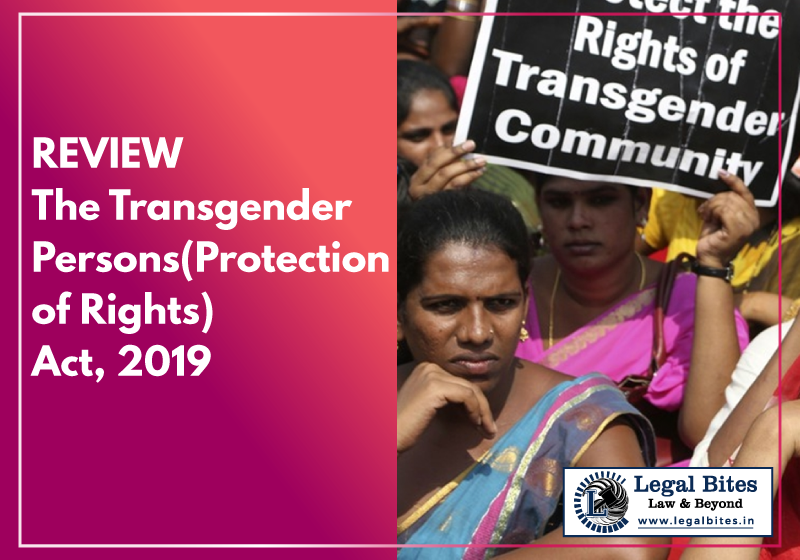Legislation Review: The Transgender Persons (Protection of Rights) Act, 2019
This Legislation Review of The Transgender Persons (Protection of Rights) Act, 2019 has been completed by Shivangi Pandia, National Law University, Nagpur. The author was adjudged the winner of National Legislative Review Competition 2020. The author has reviewed the provisions starting from long title to the subsequent sections of the act. Legislation Review: The Transgender Persons (Protection of… Read More »

This Legislation Review of The Transgender Persons (Protection of Rights) Act, 2019 has been completed by Shivangi Pandia, National Law University, Nagpur. The author was adjudged the winner of National Legislative Review Competition 2020. The author has reviewed the provisions starting from long title to the subsequent sections of the act.
Legislation Review: The Transgender Persons (Protection of Rights) Act, 2019
The transgender community, generally known as ‘Hijras’ in our country, is treated by society as unnatural beings and commonly considered as objects of ridicule and are even feared due to prevailing superstitions. After the NALSA judgment in 2014 that recognized the right of gender identity as a part of Article 21, the bill was tabled in the parliament for the protection and recognition of Transgender Persons titled –“The Transgender Persons (Protection of Rights Act), 2014”.
The bill was rejected and again tabled in 2016 with the recommendations of the Parliamentary Standing Committee on Social Justice. The committee suggested that the bill lacks a redressal mechanism and the right of self-determination of gender. The bill was passed in 2019, yet the fundamental flaws were still not corrected.
Even though there is legislation, but it suffers from various flaws that again puts the community at the vulnerable end. The very long title of the act fails to mention the word ‘Recognition’, which is of utmost importance to the community for they need recognition.
The definition clause defines ‘family’ to mean connected by blood, but when we see their arrangement of the community they live with Nayak, Nani Ma, or Mausi. This again questions the legitimacy of their family unit.
The legislation provides that gender is a self-perceived identity but in the subsequent section, the legislature seems to change their stance and says it would be determined by the District Magistrate. Also, there is no redressal mechanism or procedure given for the application, in case of rejection of the application, etc. The most severe offence that is committed against the transgender person is ‘Discrimination’ yet again the act fails to define what constitutes discrimination or provide for any penalty in case of such incidents.
The act talks about compliance procedures by educational and other institutions, but who will make sure they are complying? no such authority provided neither the penal provision prescribed for the non-compliance.
When the act fails to make any provision for penalizing for non-compliance how can one ensure that they will be followed? Criminal jurisprudence says that the punishment must be enough to deter the offender. The act provides punishment for rape, forced labour, etc against transgender to be two years of imprisonment. Is the punishment enough to deter the offenders and protect the community? This is not just grossly unjustified but is also in violation of their right to equality under Article 14.
The author has reviewed the provisions starting from long title to the subsequent sections of the act. The comparative study has been drawn by analyzing other welfare provisions like that of The SC/ST (Prevention of Atrocities Act), 1989; The National Commission for Safai Karamchari Act, 1993; POSCO; etc. It’s time we recognize the need to have well-drafted legislation addressing human rights and identity recognition for these communities.
Table of Contents
- Table of Abbreviations
- Table of Cases
- Table of Statutes
- Introduction
• Inequality Against The Transgender………………………………………………………………….. 4
• Why Gender Identity Is Essential? ……………………………………………………………………. 4
• The Proposal For The Act? ………………………………………………………………………………. 5
• History Of Enactment ……………………………………………………………………………………… 6 - Review of the Legislation
The Long Title
The Preamble
The Enacting Clause
Extent And Commencement Clause
Definitions
The Operative Section
Procedural Provisions
Offences
Penalties
Provisions Regarding Delegated Legislation - Recommendations
- Conclusion
Click Here to Read the Whole Review
Authored by:
Shivangi Pandia
National Law University, Nagpur
